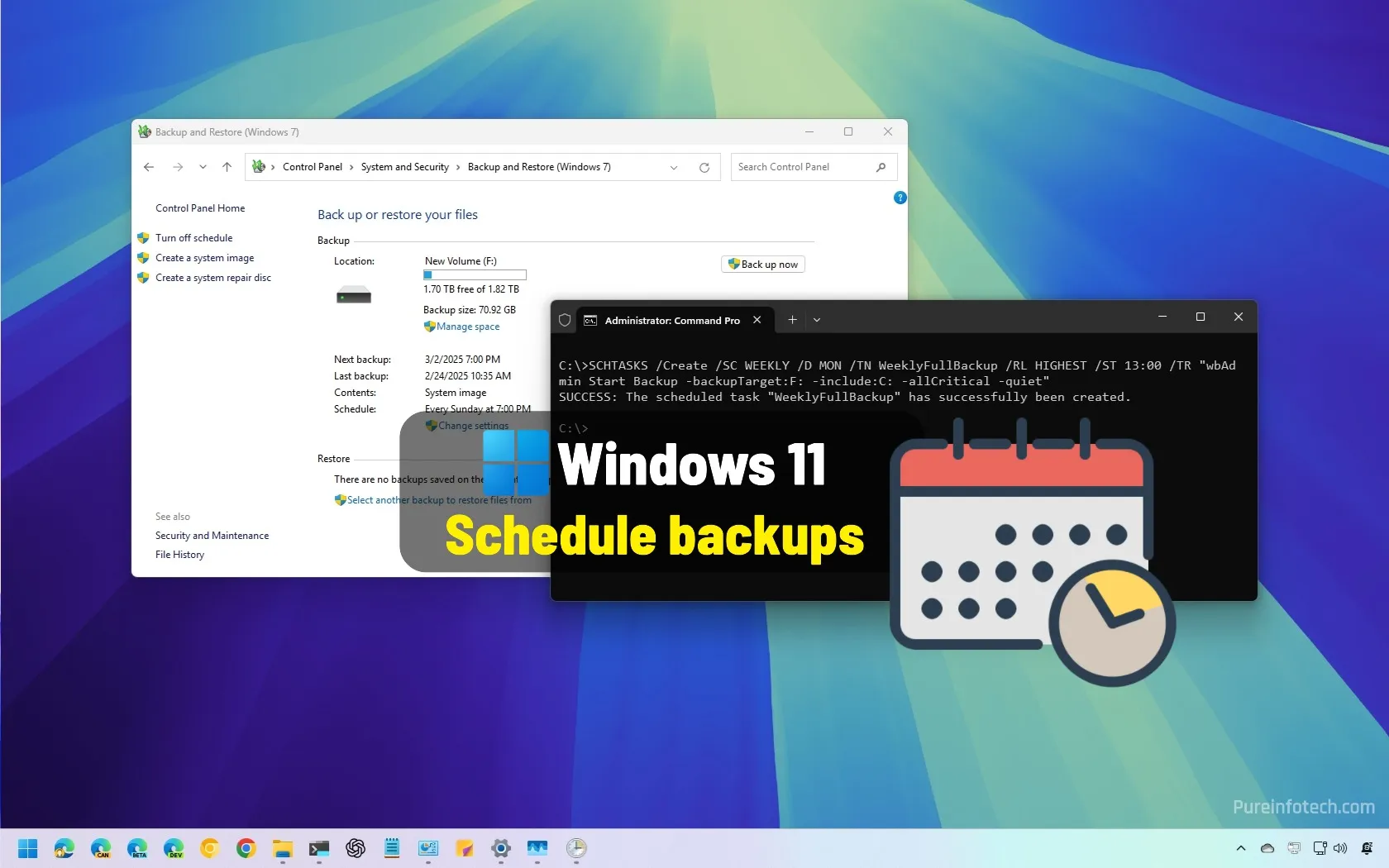How to schedule automatic full backup on Windows 11, 10

On Windows 11 (and 10), you can use the legacy “Backup and Restore” tool to schedule full backups of your computer, including installation files, custom settings, apps, and personal files. This guide explains how to complete this process.
While backing up files to an external drive or cloud storage safeguards your personal data, it doesn’t allow for complete system recovery. A system image, or full backup, protects the entire system. In case of hardware failure, virus attacks, or software issues, you can restore your device using this backup.
Remember, you can only recover the system and files from the time you created the last backup. Therefore, it’s essential to proactively and regularly create backups. To simplify this task, you can automate the process by scheduling full backups through the Control Panel or Command Prompt.
Be aware that “Backup and Restore” is no longer actively maintained, and Microsoft may remove it in future releases. However, you can still use it to create temporary full backups, such as before upgrading the system drive or updating to a new Windows release.
In this guide, I’ll outline the steps to configure automatic system image backups on Windows 11, but the instructions will also apply to Windows 10.
Schedule automatic full backup from Control Panel
To schedule automatic backups using the legacy Backup and Restore feature, connect a USB hard drive (USB flash drives are not supported) and follow these steps:
-
Open Start.
-
Search for Control Panel and click the top result to open the app.
-
Click the “Backup and Restore” setting under the “System and Security” section.
-
Click the “Set up backup” option under the “Backup” section.
-
Select the external drive to store the automatic backups.

-
Click the Next button.
-
Choose the “Let me choose” option.

-
Clear all the selected items.
-
Check the “Include a system image of drives: EFI System Partition, System (C:), Widows Recovery Environment” option.

-
Click the Change Schedule option.

-
Check the “Run backup on a schedule” option (if applicable).
-
Select the frequency (daily, weekly, or monthly) from the “How often” setting.

-
Choose the day to create the backup from the “What day” setting (if applicable).
-
Schedule the backup time in the “What time” setting.
-
Click the “Save settings and run backup” button.
After you complete the steps, the tool will immediately create an initial full backup.
It’s important to note that this guide focuses on creating a system image backup, and for this reason, I cleared the items from “Data Files” and “Computer.” However, you can always choose to back up these items.
The “Data Files” option backs up personal files and folders found in user libraries (Documents, Pictures, Music, Videos), on the desktop, and in other standard user account locations.
The “Computer” option backs up a wider set of folders, often including entire drives or additional folders outside the default user libraries.
The difference between the “Data Files” and “Computer” options and the option to create a system image is that choosing to backup “Data Files” and “Computer” allows you to restore files individually, and the image is meant to restore the entire computer if the drive fails or the operating system become unbootable.
If you’re having trouble setting up the backup schedule or cannot delete a previous configuration, you can always reset the backup settings to the factory defaults.
Schedule automatic full backup from Command Prompt
To schedule a full backup using the legacy System Image tool, connect an external drive with enough space and follow these instructions.
-
Open Start.
-
Search for Command Prompt (or PowerShell), right-click the top result, and select the Run as administrator option.
-
(Option 1) Type the following command to create a daily full image backup and press Enter:
SCHTASKS /Create /SC DAILY /TN
/RL HIGHEST /ST : -include: : -allCritical -quiet" In the command, you have to update the command with a custom name, schedule, and location to store the backup, as you see in this example:
SCHTASKS /Create /SC DAILY /TN DailyFullBackup /RL HIGHEST /ST 14:06 /TR "wbAdmin Start Backup -backupTarget:F: -include:C: -allCritical -quiet"

-
(Option 2) Type the following command to create a full backup of Windows 8.1 weekly and press Enter:
SCHTASKS /Create /SC WEEKLY /D
/TN /RL HIGHEST /ST /TR "wbAdmin Start Backup -backupTarget: : -include: : -allCritical -quiet" In the command, you have to update the command with a custom name, schedule, and location to store the backup, as you see in this example:
SCHTASKS /Create /SC WEEKLY /D MON /TN WeeklyFullBackup /RL HIGHEST /ST 13:00 /TR "wbAdmin Start Backup -backupTarget:F: -include:C: -allCritical -quiet"

Once you complete the steps, the system will create a full system image backup of your entire Windows 11 installation with apps, settings, and apps on the schedule you specified.
Understanding the backup command:
- SCHTASKS: Command version of the Task Scheduler.
- /Create: Instructs SCHTASKS to create a new scheduled task.
- /SC DAILY: This option sets the schedule frequency to daily.
- /SC WEEKLY: This option sets the schedule frequency to weekly.
- /D: If you use the WEEKLY option, this switch lets you specify the day of weekly to run the task.
- /TN
- /RL HIGHEST: Runs the task with the highest privileges (administrator level).
- /ST
- /TR: Defines the action to execute. In this case, it’s the
wbAdmincommand for backup.- wbAdmin Start Backup: Initiates the backup operation.
- -backupTarget:
- -include:
- -allCritical: Ensures all critical volumes required for the operating system to run are included in the backup.
- -quiet: Runs the backup without prompting for user input.
- -backupTarget:
- wbAdmin Start Backup: Initiates the backup operation.
If you want to determine whether the task has been fully created. Open the Task Scheduler from the Start menu, open the “Task Scheduler Library,” and on the list from the right, you should be able to find the task.
This is also a good place to start the troubleshooting process if the backup isn’t running correctly. You can always right-click and delete the task from the Task Schedule to stop creating backups.
Source link






